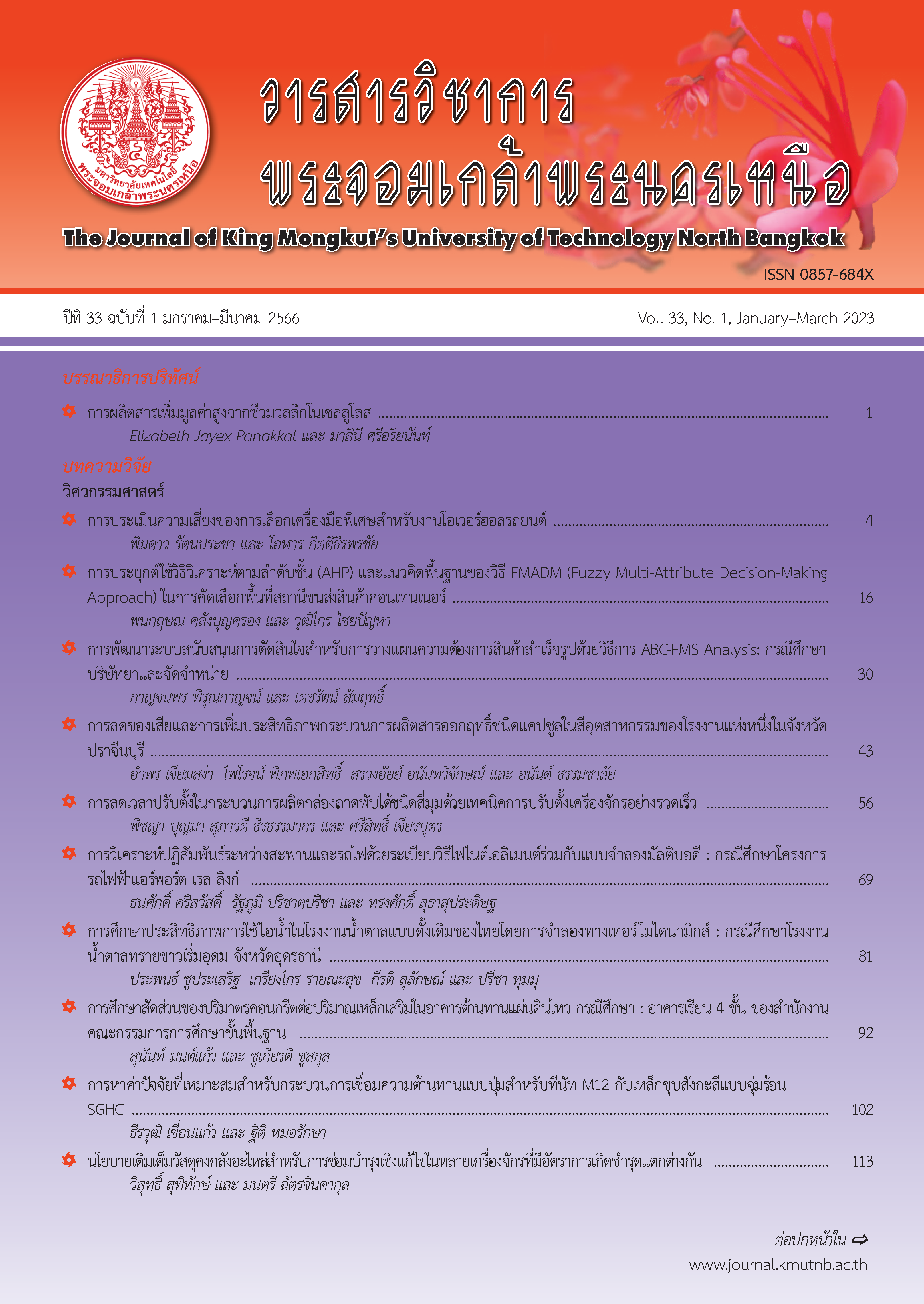การปรับแก้ความคลาดเคลื่อนปริมาณน้ำฝนจากแบบจำลอง WRF-CFSR โดยวิธี EOF ภาคเหนือตอนบนของประเทศไทย
Main Article Content
บทคัดย่อ
ระบบแบบจำลองภูมิอากาศเป็นงานที่มีความท้าทายและมีความยาก เนื่องจากการประมวลผลจากแบบจำลองมีความไม่แน่นอนซึ่งเกิดจากหลายปัจจัยส่งผลต่อความคลาดเคลื่อนของผลการจำลองทั้งในเชิงพื้นที่และเวลา ฉะนั้นในการศึกษาครั้งนี้จึงมีวัตถุประสงค์ในการประยุกต์ใช้วิธีการหรือเทคนิคการปรับแก้ความคลาดเคลื่อนสำหรับปริมาณน้ำฝนจากแบบจำลองสภาพอากาศระดับภูมิภาค WRF-CFSR และประเมินประสิทธิภาพวิธีการปรับแก้ความคลาดเคลื่อนปริมาณน้ำฝนจากแบบจำลองสภาพอากาศระดับภูมิภาค WRF-CFSR โดยในการศึกษาได้เลือกใช้วิธีการ Empirical Orthogonal Function (EOF) ในการปรับแก้ความคลาดเคลื่อนปริมาณน้ำฝนแบบรายเดือน โดยศึกษาในพื้นที่ภาคเหนือตอนบนของประเทศไทยทั้งหมด 18 สถานี ครอบคลุมตั้งแต่ปี ค.ศ. 1980-2010 (31ปี) และใช้ข้อมูลตรวจวัดแบบกริด (APHRODITE CRU และGPCP) ในการเปรียบเทียบผลร่วมกับข้อมูลแบบจำลองสภาพอากาศระดับภูมิภาค WRF-CFSR จากการศึกษาพบว่าวิธีปรับแก้ EOF สามารถลดค่าความแตกต่างระหว่างค่าปริมาณน้ำฝนผิดปกติและค่าปริมาณน้ำฝนปกติเฉลี่ยให้มีความใกล้เคียงกับค่าความแตกต่างของข้อมูลตรวจวัด และในการตรวจสอบความถูกต้องด้วยค่ารากที่สองของค่าความคลาดเคลื่อนกำลังสองเฉลี่ย (RMSE) พบว่าวิธีการปรับแก้ความคลาดเคลื่อน EOF ยังไม่สามารถลดค่าความคลาดเคลื่อนของปริมาณน้ำฝนได้ แต่อย่างไรก็ตามจากการตรวจสอบความถูกต้องด้วยค่าสัมประสิทธิ์สหสัมพันธ์ (r) พบว่าวิธี EOF สามารถรักษาความต่อเนื่องเชิงพื้นที่ของปริมาณน้ำฝนรายเดือนได้ โดยเฉพาะการปรับแก้ข้อมูลแบบจำลองสภาพอากาศระดับภูมิภาค WRF-CFSR และข้อมูลตรวจวัดกริด GPCP มีค่า r อยู่ในช่วง 0.52 ถึง 0.97 ซึ่งเป็นค่าความสัมพันธ์หลังปรับแก้ที่ดีที่สุด
Article Details

อนุญาตภายใต้เงื่อนไข Creative Commons Attribution-NonCommercial-NoDerivatives 4.0 International License.
บทความที่ลงตีพิมพ์เป็นข้อคิดเห็นของผู้เขียนเท่านั้น
ผู้เขียนจะต้องเป็นผู้รับผิดชอบต่อผลทางกฎหมายใดๆ ที่อาจเกิดขึ้นจากบทความนั้น
เอกสารอ้างอิง
J. Nels, The Effects of Topography on the Climate. United States, 2017.
W. Wanwisad, Climate Change: Effects to Thailand. Bangkok, 2015 (in Thai).
J. P. Evans and D. Argüeso, “Guidance on the use of bias corrected data,” University of New South Wales, Australia, 2014.
L. Feudale and A. M. Tompkins, “A simple bias correction technique for modeled monsoon precipitation applied to West Africa,” Geophysical Research Letters, vol. 38, no. 3, pp. 1–5, 2011.
C. Chotamonsak, E. P. Salathé, J. Kreasuwan, S. Chantara, and K. Siriwitayakorn, “Projected climate change over Southeast Asia simulated using a WRF regional climate model,” Atmospheric Science Letters, vol. 12, no. 2, pp. 213–219, April 2011.
Y. Wang, L. R. Leung, J. McGregor, D. Lee, W. Wang, Y. Ding, and F. Kimura, “Regional climate modeling: Progress, challenges, and prospects,” Journal of the Meteorological Society of Japan, vol. 82, no. 6, pp. 1599–1628, 2004.
X. Yang, E. F. Wood, J. Sheffield, L. Ren, M. Zhang, and Y. Wang, “Bias correction of historical and future simulations of precipitation and temperature for China from CMIP5 models,” Journal of Hydrometeorology, vol. 19, no. 3, pp. 609–623, 2018.
T. Thodsang, A. Chankarn, S. Kitiraj, K. Sinonpakorn, and S. Boonyaarunneth, “Analysis and accuracy of the weather research and forecasting model (WRF) for climate change prediction in Thailand,” in Proceedings 19th NCCE, 2014, pp. 1–8 (in Thai).
S. Saha, S. Nadiga, C. Thiaw, J. Wang, W. Wang, Q. Zhang, H. M. Van den Dool, H.-L. Pan, S. Moorthi, D. Behringer, D. Stokes, M. Peña, S. Lord, G. White, W. Ebisuzaki, P. Peng, and P. Xie, “The NCEP climate forecast system,” Journal of Climate, vol. 19, no. 15, pp. 3483–3517, 2006.
S. Saha, S. Moorthi, H.-Lu Pan, X. Wu, J. Wang, S. Nadiga, P. Tripp, R. Kistler, J. Woollen, D. Behringer, H. Liu, D. Stokes, R. Grumbine, G. Gayno, J. Wang, Y.-Tai Hou, H.-ya Chuang, H.- Ming, H. Juang, J. Sela, M. Iredell, R. Treadon, D. Kleist, P. Van Delst, D. Keyser, J. Derber, M. Ek, J. Meng, H. Wei, R. Yang, S. Lord, H. van den Dool, A. Kumar, W. Wang, C. Long, M. Chelliah, Y. Xue, B. Huang, J.-Kyung Schemm, W. Ebisuzaki, R. Lin, P. Xie, M. Chen, S. Zhou, W. Higgins, C.-Zhi Zou, Q. Liu, Y. Chen, Y. Han, L. Cucurull, R. W. Reynolds, G. Rutledge, and M. Goldberg, “The NCEP Climate Forecast System Reanalysis,” Bulletin of the American Meteorological Society, vol. 91, no. 8, pp. 1015–1058, 2010.
S. Saha, S. Moorthi, X. Wu, J. Wang, S. Nadiga, P. Tripp, D. Behringer, Y.-Tai Hou, H.-ya Chuang, M. Iredell, M. Ek, J. Meng, R. Yang, M. Peña Mendez, H. van den Dool, Q. Zhang, W. Wang, M. Chen, and E. Becker, “The NCEP climate forecast system version 2,” Journal of Climate, vol. 27, no. 6, pp. 2185–2208, 2014.
C. Chotamonsak, O. Wiranwetchayan, D. Lapyai, and P. Thanadolmethaphorn, Seasonal Climate Forecasting Model for Rice Yield Prediction Model for Thailand. Chiangmai, 2018 (in Thai).
K. Kusreesakul, “Spatio-temporal rainfall changes in thailand and their connection with regional and global climate variability,” M.S. thesis, Faculty of Enviromental Management, Prince of Songkla University, 2009 (in Thai).
A. Limsakul and W. Paengkaew, “Empirical orthogonal function (EOF) technique and ocean variability analysis,” Burapha Science Journal, vol. 18, no. 2, pp. 313–320, 2013 (in Thai).
A. Yatagai, APHRODITE’s Water Resources project. Kyoto, Japan, 2012.
I. Harris, Release Notes for CRU TS v4.02. University of East Anglia Norwich, 2018.
Q. Sun, C. Miao, Q. Duan, H. Ashouri, S. Sorooshian, and K.-Lin Hsu, “A review of global precipitation data sets: Data sources, estimation, and intercomparisons,” Reviews of Geophysics, vol. 56, no. 1, pp. 79–107, 2018.
A. Pendergrass, The Climate Data Guide: GPCP (Monthly): Global Precipitation Climatology Project. United States, 2014.
A. Hannachi, I. T. Jolliffe, and D. B. Stephenson, “Empirical orthogonal functions and related techniques in atmospheric science: A review,” International Journal of Climatology, vol. 27, no. 9, pp. 1119–1152, 2007.
J. V. Ratnam, T. Doi, and S. K. Behera, “Improving austral summer precipitation forecasts of SINTEX-F2 coupled ocean–atmosphere general circulation model over southern Africa by simple bias correction techniques,” Atmospheric Science Letters, vol. 20, no. 3, pp. 1–8, 2019.

